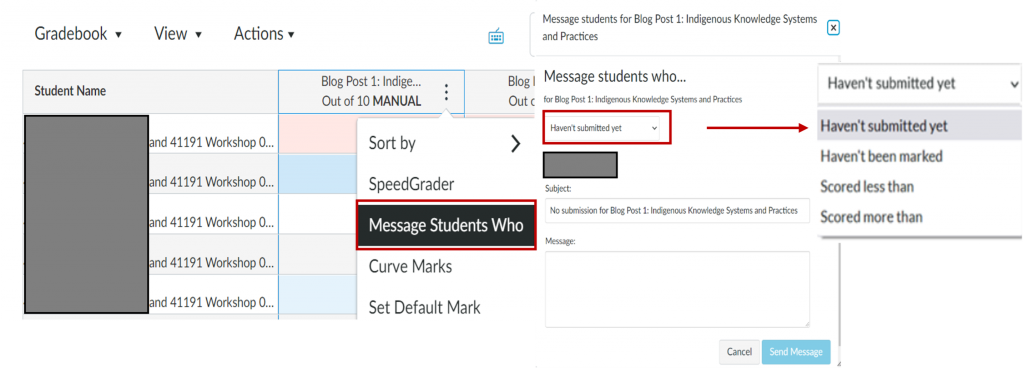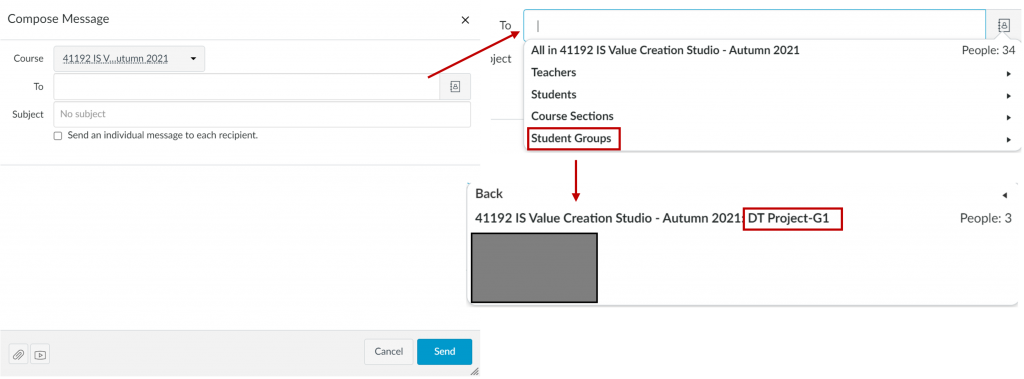This post is a collaboration between Simon Buckingham Shum (CIC), Lisa-Angelique Lim (CIC), David Yeats (IML LX.Lab), Martin van de Weyer (IML LX.Lab), and Amara Atif (FEIT).
Feedback is a key issue in learning and teaching at university, with many students expressing dissatisfaction with the timeliness and extent to which it is personalised for actionability. With large cohorts and an increasing use of virtual learning spaces, academics also face the challenge of being able to provide timely and personalised feedback.
Learning Analytics enable academics to leverage automated feedback systems to address these challenges. LX.lab and the Connected Intelligence Centre (CIC) just wrapped up a series of workshops on Automated Feedback tools, showing the range of systems available at UTS, and showcasing how these are being used by academics.
In this blog, we continue the conversation by describing an approach we call Activity-Based Conditional (ABC) messaging. A simple form of ABC messaging can be handled using the Canvas ‘Message Students Who‘ function. FEIT’s Amara Atif has used this in her subjects, to communicate regular and personalised feedback to students who are less engaged. Amara shares her process below.
Using ABC messaging
With a background in learning analytics, I am always keen on finding out when and on what factors we teachers can rely upon to detect disengagement in the online or hybrid learning context.
I’m going to share how the built-in ABC messaging in Canvas has helped me to understand my students’ learning behaviours, by sending them timely interventions, and using as in-class feedback for the assignments.
My intention for using ABC messaging within Canvas was to offer support to students while they are still enrolled in the subject and able to influence their success/failure before the semester ends.
Amara
I have used Canvas ABC messaging in three-ways:
- New Analytics tool
- Marks (Gradebook)
- Inbox messaging tool
Firstly, it is important to decide on two important things:
- The indicators by which we want to identify disengaged students. Based on my Canvas subject sites, I used Course Discussions (class participation in the weekly case studies set up as discussions) and Course Grade (missing/low mark) for students who have not submitted yet and/or scored below a certain mark.
- The time stamps i.e., when we want to contact students. With the increased teaching load and other related responsibilities, I decided to contact my students before the Census date (Week 4), soon after the first assessment task was due (early Week 6) and then soon after the marks of the first (early week 8) & second assessment task were released (early week 10).
Using New Analytics
In a recent blog post (Analyse this: improving student engagement with New Analytics in Canvas), I shared examples of how New Analytics has helped me improve student engagement in my first-year UG subjects (including a studio) in Autumn 2021 and a second-year PG subject in Spring 2020. You may also like to read more on the various reasons to use New Analytics in Canvas to improve your students’ learning experience.
Within Marks (Gradebook)
I contacted students who haven’t submitted the assignment in Gradebook as in the screenshot below. Students will receive this message in their student email.

Via Inbox messaging tool (Conversations)
I contacted individual students and/or groups of students via the inbox messaging tool. The screenshot below shows how I have sent a message to a group of 3 students for having an incomplete group reflective commentary. Students will receive this message in their student email and also in Canvas.

Writing an ABC feedback message
- Always add subject headings to your messages, so the student knows for what purpose they have been contacted.
- Add your signature to your messages, so the student knows who is contacting them.
- Compose your messages clearly. The following is a suggested template:
- State the problem.
- Remind the student of the importance of an aspect of the subject, or of a certain behaviour.
- Provide a solution, or a clear message of expected behaviour.
- Offer support or words of encouragement.
- Try to avoid communicating the threat of impending doom.
Research has shown that students are likely to receive feedback messages well when the message is personal to them, and when they can perceive your care. Even just starting off your message with a simple question about how they are going at this stage in their studies, can be enough to elicit openness to your message.
Composing an effective message is a challenging task. Make sure to ask a teaching team member or colleague to review your messages. Below is a sample message, I have used on missing an assessment task.
Dear STUDENT NAME,
I have noticed that you did not submit your Assessment Task 1: XXX. This means that I am concerned about your performance in this subject. Remember that you can check on the due dates of all assessments in the subject outline, available at [Link provided here]. It would be a good idea to write these dates in your calendar with reminders.
If you are finding this subject difficult, I encourage you to set-up a meeting with me to discuss this concern.
I want you to succeed and I believe in your abilities to be successful.
Kind regards,
Subject Coordinator Signatures
The outcome of this messaging strategy has been increased student engagement and several positive student responses to personalised feedback which you can read more about in Analyse this: improving student engagement with New Analytics in Canvas.
Resources for using Messaging within Canvas
- Learn more about Canvas New Analytics and read a brief introduction to Criteria-based messaging.
- Keep an eye on our LX.lab Events for upcoming Canvas training workshops prior to Spring.
- Got questions about Canvas ABC Messaging? Log a ticket via LX.lab Support on Service Connect.
Feature image by Erica Steeves.

Thanks Simon, Lisa, Amara, David, Martin – what you write about indicators and time stamps is a really good way to ensure that feedback becomes a dialogue and not just given after assessments. It’s tricky to be personal when we know little about our students (if we teach online and students don’t use cameras or microphones), so this also points to the importance of relationship-building and social presence in the classroom or classZoom.